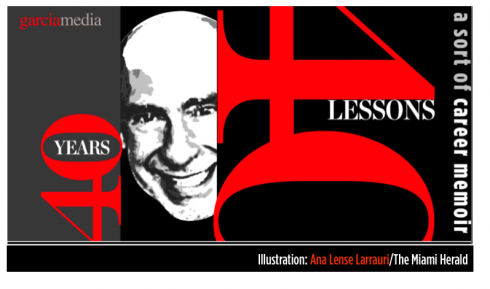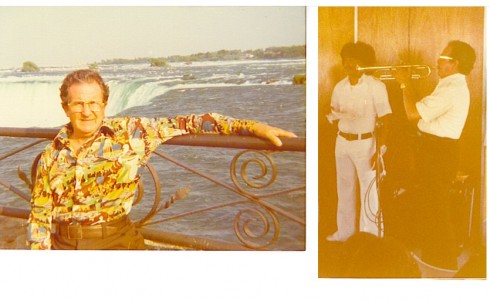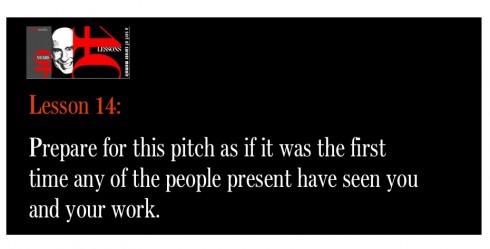TAKEAWAY: This is part 14 of my occasional series 40 Years/40 Lessons, which I call a “sort of career memoir” capturing highlights and reminiscing about what has been a spectacular journey for me, doing what I love most. Today’s segment: pitching that job.


Illustration by Ana Lense Larrauri/The Miami Herald


He was our own Mambo King: Tio Kiko, a colorful man with colorful shirts and a master of the trumpet, where he played songs of love
It is all about competition in this country, my uncle Hector, the barber, told me the second day I had arrived in the United States in 1962. But, my Tio Kiko, as we in the family referred to him, added: this is the place where you compete for everything, and if you are good you make it.
You see, Tio Kiko was a barber by day but played a mean trumpet in those Miami Beach nightclubs of another era by night. Think API or Poynter.
Good thing. This is America, land where competition thrives, and the best person wins. Tio Kiko had it right.
But with each pitch comes anxiety, fear, the nervous stomach, the night before with little sleep for some, and, of course, that big red sign we all hate to see in front of our faces: rejection.
And not all pitches are the same.
Some pitches require that we come armed with about 10 pages of how we would proceed to design this particular publication. Usually a fee is charged for that, but one always wonders if any of the ideas stay in the background for “future referrals”.
Other pitches are cold as last week in Helsinki for me: you arrive, you show the best of…….you (hard to make those choices, but remember, FIVE pieces is better than 50), but what to include, what to edit out. In my view: you study the potential client, examine his needs, and, see where your portfolio meets their expectations. And, please, beware of cultural differences: don’t drag your portfolio pieces with the bikini girls and the male models showing bare chests if you are in a country where such things are a no no. Common sense and portfolio preparation go together.
During the pitch
So now the day arrives and you are there, ready to show these people that nobody does it like you, and that they would be absolutely wrong and disappointed if they went with anyone but the one and only. Of course, you don’t say any of this directly. You infer it. Your portfolio pieces suggest it. And you tell them how you work, how you like people, and like you believe in collaborations. If you are not serious about these qualities, you should not be pitching, anyway.
I confess that I have never felt anxiety or lost sleep over a pitch. I prepare. Period. You prepare as if it was the first time any of these people would see you or hear you. You don’t rest on your laurels, which can be bloody thorny when trusted too seriously. There will always be people judging you in this gathering who have heard soooooooooooooooo much about you, and think you are a legend, and even a guru. Nonsense. A pitch is where you pretend that this is your first presentation. It has always helped me to work better at it.
A pitch is NOT the moment to push the automatic pilot button.
Very important: the last sentence before you leave the room is key. It stays with these people who have the ability to determine your destiny, at least momentarily.
Leave smiling. Remind them that NO MATTER who they select , the important thing is that they are doing the right thing in seeking help, going for a rethinking, and that you, of course, would be honored to join them in their journey.
Finally, the news of the pitch
Tip after you leave the pitch session: don’t go counting days until you hear from the possible client.
Go about your business, put the pitch behind you and be proud of what you did to secure the job, but don’t go on overdrive about it (easier said than done, especially with some jobs we really want).
Then the phone rings. The first sentence from the spokesperson in charge of delivering the verdict says it all:
If they say: We have been so honored that you joined us for this pitch.…… (kiss of death: nice to have seen you, but we picked another consultant).
If they say: This was not an easy decision for us…. (same thing put differently: they belabor the point that you and someone else were the finalists, but only one could be picked, and you already know it was not you; as honored as you may be to have placed a closed second, you ain’t it , kid…..)
Try telling the first runner up in the Miss Universe contest that she was close to winning. She is returning to the Ukraine, while Miss Venezuela gets a luxurious pad in New York City from where she shutters around the world.
And, of course, the nice clients CALL you. These are the ones whose mothers taught them good manners.On the other hand, there are those who never call you to give you the results of their verdict. To them, you are dead meat. You are not important. In those cases, you hear who the winner of the pitch is thru the rumor mills, or read it in a blog (gasp). There is no excuse for this type of behavior.
One usually loses to a worthy competitor who is probably going to do a great job, so I normally send a note to the client that wasn’t to tell him that, indeed, they are in good hands.
After that, take 24 hours to study what went wrong (was it the color of that rosé tie I wore)? Then, move on to your next project, plan the next pitch, and don’t dwell on what could have been.
And, you know, sometimes you get that project later, on the rebound.
Don’t be too proud! Just get your trumpet out of its case, aim it to the skies, and get ready for your solo, the way Tio Kiko always did.
Let the cha cha begin.
Footnote: Tio Kiko was not the only member of my family who played a musical instrument. In fact, Tio Kiko, who was my father’s brother, was one of five brothers and two sisters, all musicians, with their own orchestra, the Havana Boys. Not only did they pitch their talent individually, but also as a group.


1.Mirrors.
https://www.garciamedia.com/blog/articles/40_years_40_lessons_1—a_look_in_the_mirror
2.Refugee.
https://www.garciamedia.com/blog/articles/40_years_40_lessons_2—refugee
3.Teacher.
https://www.garciamedia.com/blog/articles/40_years_40_lessons_3—teacher/
4.Mentors.
https://www.garciamedia.com/blog/articles/40_years_40_lessons_4—mentors/
5.Consultant.
https://garciamedia.com/blog/articles/40_years_40_lessons_5—consultant/
6.Eagle.
https://garciamedia.com/blog/articles/40_years_40_lessons_6eagke
7.Abroad.
https://garciamedia.com/blog/articles/40_years_40_lessons_7._abroad
8. Books
https://garciamedia.com/blog/articles/40_years_40_lessons_8_books
9. Luck
https://garciamedia.com/blog/articles/40years_40_lessons_9_luck
10. Positive.
https://garciamedia.com/blog/articles/40_years_40_lessons_10positive
11. Culture
https://garciamedia.com/blog/articles/40_years_40_lessons_11_culture
12.Adapting.
https://www.garciamedia.com/blog/articles/40_years_40_lessons_12_adapting1
13.Dreams
https://www.garciamedia.com/blog/articles/40_years_40_lessons_13_dreams
Easier to get on those German trains now

If you ride German trains, and if you have an iPad, now the German national railways has launched a visually appealing and information-packed new iPad application that plots your routes using Google Maps. Above is a sample trip across the Alps to Milan. As an added bonus, the application will even add trips to your calendar. Thanks to David McCreery for sharing the info with us.
TheMarioBlog post #746